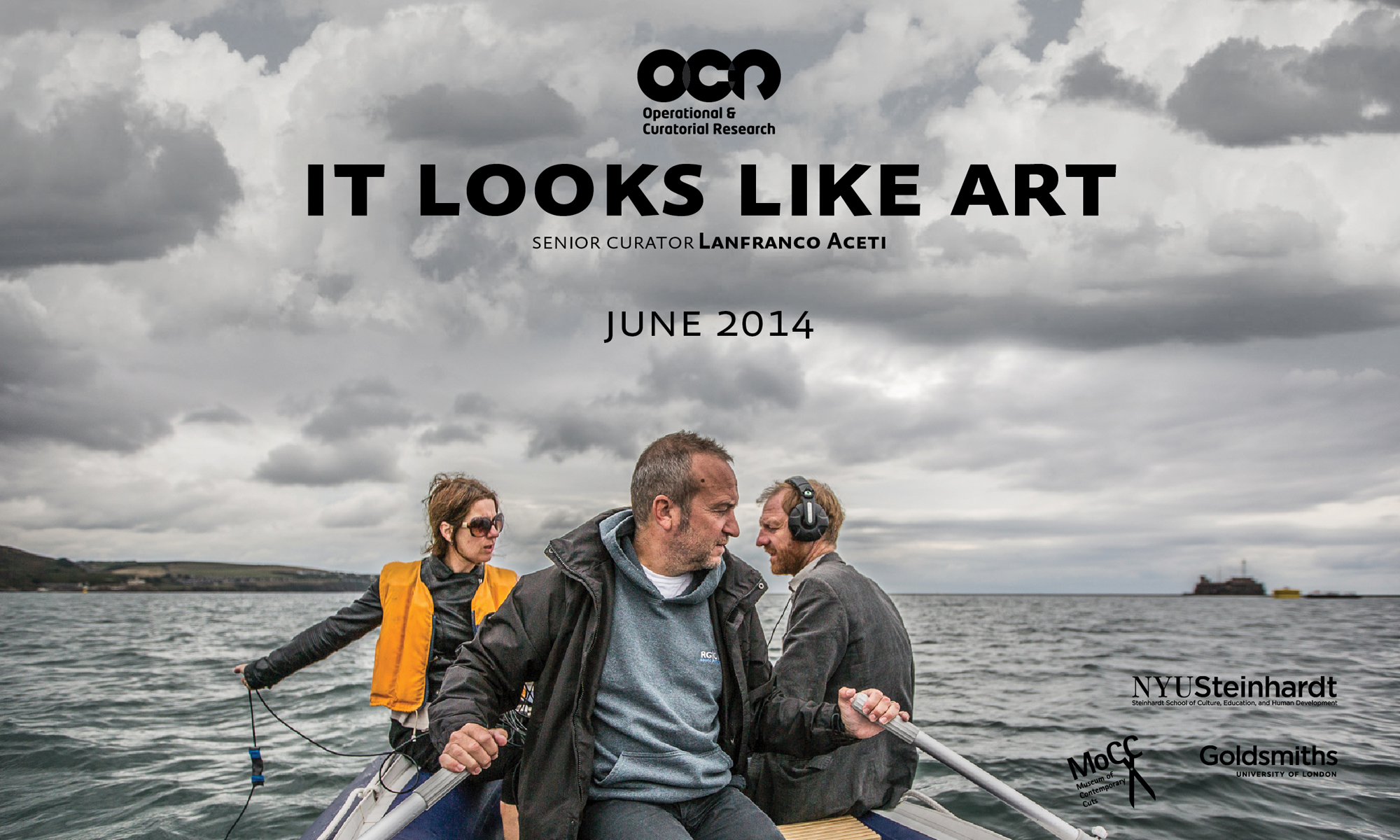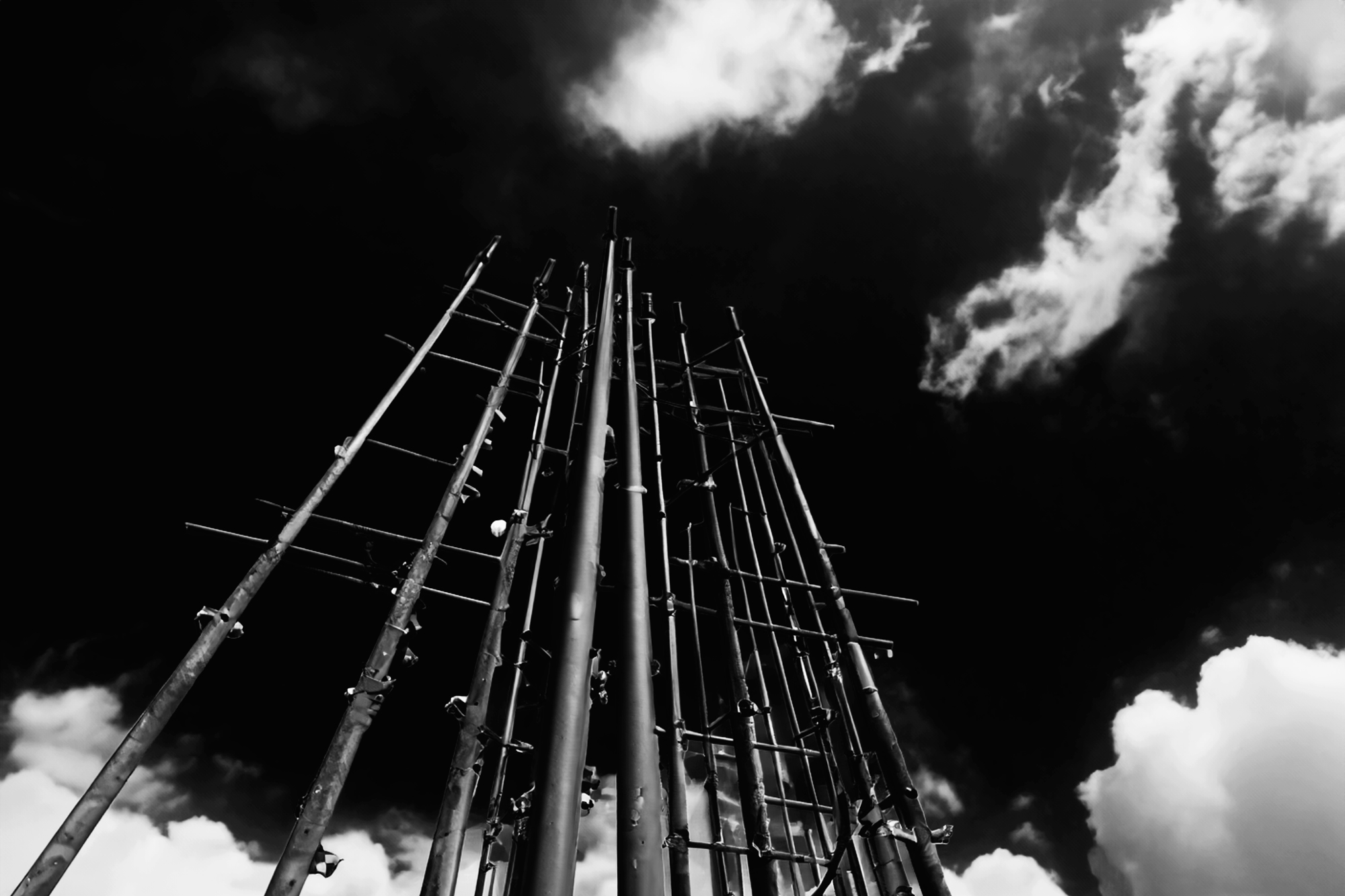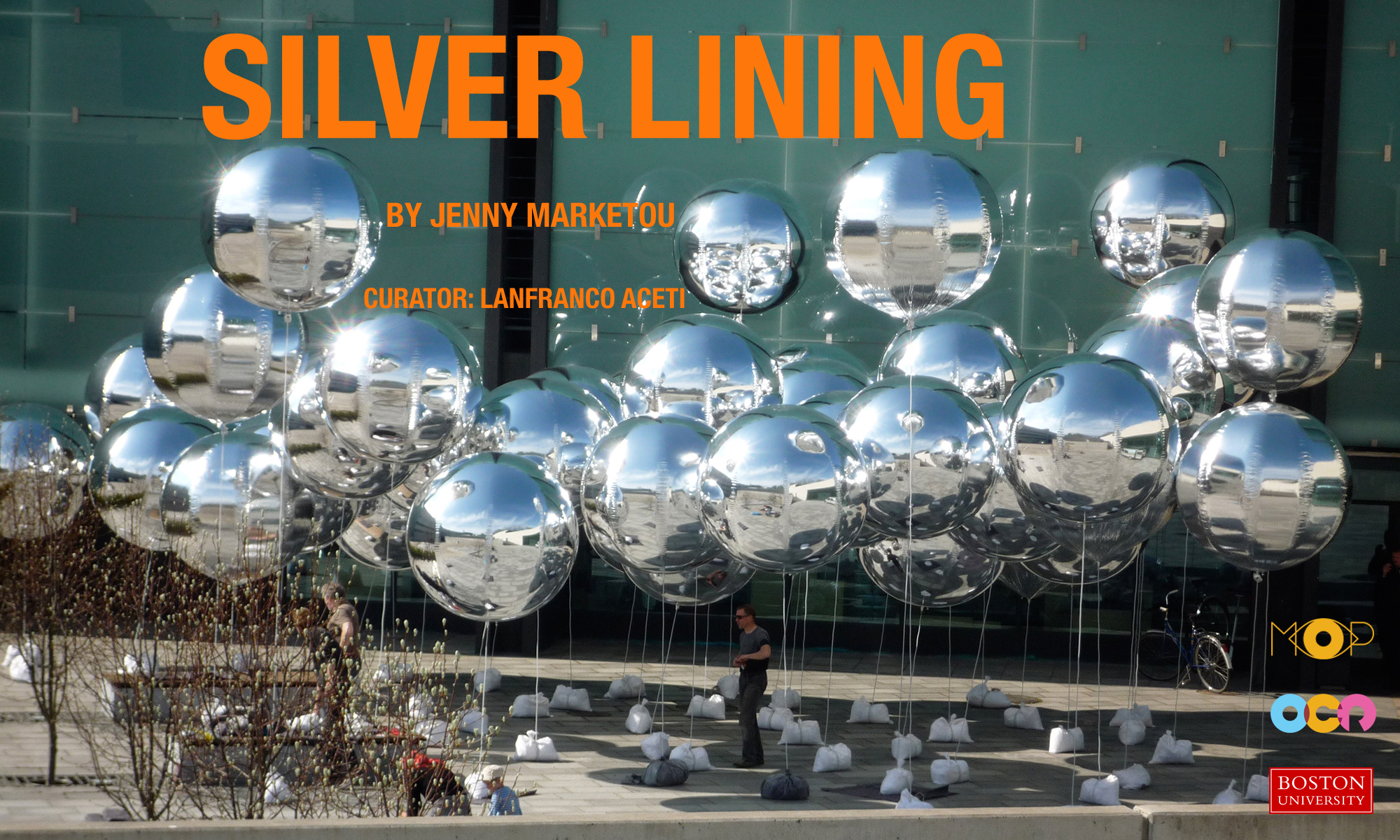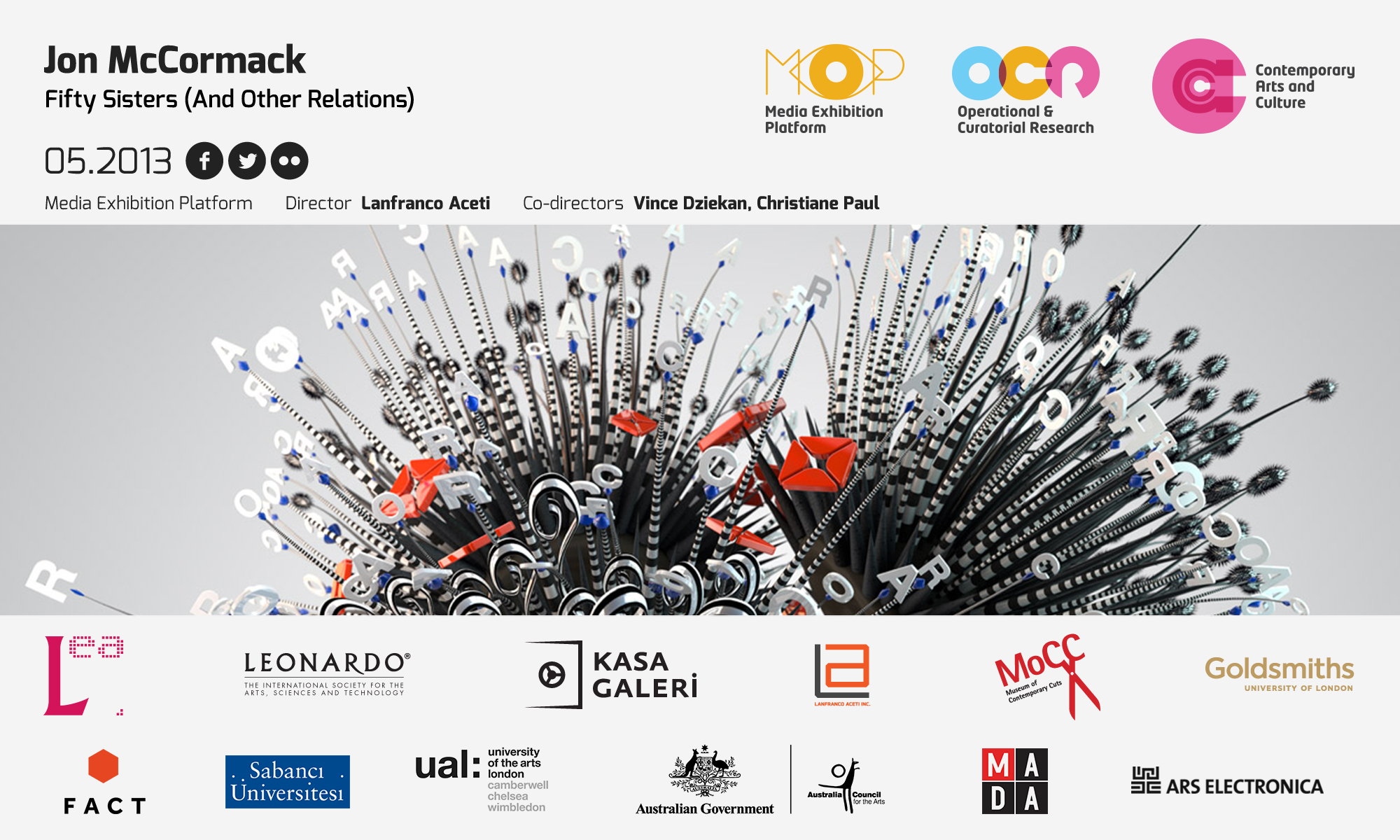It Looks Like Art is the new exhibition of OCR on its Media Exhibition Platform (MEP) that coincides with the Sound Art Curating Conference that we organized at Goldsmiths and the Courtauld. The exhibition is an international collaboration that sees the partnerships of OCR, NYU Steinhardt, Goldsmiths, Kasa Gallery and other international institutions.
The exhibition is a counterpoint to the show at Kasa Gallery titled It Sounds Like Art. The exhibition looks at the complex relationship between sound art and visuals through a variety of artistic and aesthetic practices.
You can follow the exhibition development and accretion online via Facebook and Twitter.
Is the relationship between sounds and visuals an inextricable one? What sensibilities and approaches are required in order to engage with sounds in an aesthetic context? Is there a conflict between sound and visuals that underpins hierarchical relationships or could we say that sound art has developed a new hierarchical order within which the visual plays an ancillary role, traditionally the ‘realm’ of sound?
As sound art practices evolve and develop, new constructs and artistic approaches emerge which bend – sometime harmoniously, sometimes conflictingly – old relationships and frameworks in order to construct new aesthetics and new fine art practices beyond old dichotomies and set operational structures.
Image Credit: FATHOM, Jane Grant and John Matthias, 2013. Jane Grant, Simon Honywill and John Matthias making hydrophone recordings in Plymouth Sound. Photograph by Guy Harris, 2013. Used with permission.
Senior Curator: Lanfranco Aceti.
Curator: Jonathan Munro.
Exhibition Dates: May 15 – June 30, 2014.
Where: Media Exhibition Platform (MEP)
You can follow developments for Lanfranco Aceti Inc., OCR and the Museum of Contemporary Cuts (MoCC) via the newsletter.
ARTISTS’ BIOGRAPHIES
James Bulley
James Bulley (b.1984) is an artist, curator and researcher. His work focuses upon exploring new methods of sound composition through site-specific installation and landscape. He is currently completing a PhD in Sonic Arts, at Goldsmiths, University of London, studying under Dr John Drever and Professor Janis Jefferies. He is graduate representative for the Goldsmiths Sound Practice Research Unit and is a member of the New Radiophonic Workshop under Matthew Herbert. In 2010 he co-curated Oramics to Electronica at the Science Museum (ongoing), a result of his continuing work archiving the Daphne Oram collection. In 2011 he co-curated the Sho-Zyg sound show case, a week long exhibition and events programme featuring work from over 50 artists working with sound alongside exhibition rooms exploring the work of Daphne Oram and Hugh Davies.
As an artist and composer, Bulley has shown and performed at venues including the Queen Elizabeth Hall, the Barbican Gallery, the Museum of Science and Industry and La Gaîté Lyrique. His work has been featured by the BBC, ITV, The Quietus, The Daily Telegraph, The Financial Times and Dazed & Confused. In 2012, a collaboration with the artist David Shearing, and it all comes down to this, was awarded gold medal for Installation Design at World Stage Design. In 2013, in partnership with the systems artist Daniel Jones, he was nominated for British Composer of the Year (for the installation work Radio Reconstructions) and was commissioned by Sound and Music, the Forestry Commission and the Arts Council to create and tour a new work across Summer 2014, Living Symphonies, a multi-channel forest-based sound work that translates areas of four British forests into emergent symphonic landscapes.
John Levack Drever
Operating at the intersection of sound arts, soundscape studies and acoustics, Drever’s work represents an ongoing inquiry into the affect, perception, design and practice of everyday environmental sound and human utterance. Projects are often derived from extensive fieldwork. Drever is a Senior Lecturer in Composition at Goldsmiths, University of London, where he leads the Unit for Sound Practice Research. He is also a Visiting Research Fellow at Seian University of Art and Design, Japan.
Sublime-sound‐of‐the‐one‐hand [Ryōan-ji] continues Drever’s exploration into ochlophonics – the notion of the crowded soundscape and the feeling of being crowded by the soundscape. On this occasion the location is the 15th Century dry Zen‐garden Ryōan‐ji in Kyoto, recorded during the cherry blossom season in 2011. Comprised of fifteen stones, although fourteen are only visible from any one point of view, Ryōan‐ji is a UNESCO World Heritage Site and has provoked response from many artists including John Cage and David Hockney.
Max Eastley
Max Eastley is an internationally recognized artist who combines kinetic sculpture and sound into a unique art form. His sculptures exist on the border between the natural environment and human intervention and use the driving forces of electricity, wind, water and ice. He has exhibited both interior and exterior works internationally. His work is represented in the permanent collection of the Centre for Art and Media, Karlsruhe, Germany.
Since 2003 he has been an artist with the Cape Farewell Climate Change Project for whom he has created a number of installations, compositions and performances.
He is currently an Arts and Humanities Research Council Senior Researcher at Oxford Brookes University, investigating Aeolian phenomena through artistic practice and historical research, and is currently one of the artists involved in a project, Audible Forces, touring festivals in the UK, using the wind as an energy source.
His latest exhibition was at the Water Tower (Wasserturm) in Prenzlauer Berg, Berlin: a cavernous, labyrinthine space in which he installed ten acoustic sculptures. On the roof of the building he erected 8 Aeolian harps and their live sound was projected into the interior of the building to mix with the acoustic sounds.
He is well known as a musician and has played solo concerts and with numerous other musicians such as David Toop, Evan Parker, Steve Beresford, Alex Kolkowski and Rhodri Davies.
Jane Grant
Jane Grant is an artist and academic. Her collaborative work has resulted in award winning projects including, The Fragmented Orchestra with John Matthias and Nick Ryan which was winner of the PRSF New Music Award, 2008 and received an Honorary Mention at Prix Ars Electronica 2009. The Fragmented Orchestra was exhibited at FACT and 23 sites across the UK. Her recent work includes Soft Moon and Leaving Earth; both films draw upon astrophysics and science fiction. Her sonic artwork Ghost was premiered at ISEA Istanbul 2011. In this work the temporal, topological networks and pathways of the cortex are explored in conjunction brain hallucination or ‘sonic ghosts.’ Plasticity, a collaborative work with John Matthias, Kin and Nick Ryan was recently exhibited at the BFI as part of the onedotzero festival, Google Campus London and HWK, Institute for Advanced Study in Germany. Jane is currently working on Heliosphere, a large-scale project about the ionosphere as the interface between the Earth and the Sun, a multi-screen film, Other Worlds about the interaction of the atmosphere of the Earth and its influence in looking into space. Jane, alongside John Matthias was commissioned by the River Tamar Project to create Fathom a huge sonic art work that created a sonic surface 6ft above the floor. On entering the building, visitors were immersed in an underwater sound-environment where the minute fluctuations of the sea are heard as they moved around the space. These fluctuations were marked by waves of live and recorded sound moving across the building triggered by environmental events, the tides in confluence with the Tamar Estuary.
With John Matthias, Jane co-directs the NeuroArts, an international series of symposia that brings together artists, scientists and philosophers. NeuroArts is an interdisciplinary exploration and interrogation of the field, an exchange of ideas between artists, writers, experimenters and theoreticians.
Jane writes about noise, science and art and the mutability of matter. She is Associate Professor (Reader) in Digital Arts at Plymouth University, co-director of the research group art and sound and Principle Supervisor in the Planetary Collegium, CaiiA-Node.
Nigel Helyer
Dr. Nigel Helyer (a.k.a. DrSonique) is an independent sound-artist who has forged an international reputation for large scale sound-sculpture installations, environmental public artworks, museum inter-actives and new media projects. Nigel is a longstanding collaborator at the SymbioticA lab UWA, realising such projects as GeneMusiK a biological music remixing system, the insect installation Host and as the Artistic Director of the infamous LifeBoat project shown in Oslo Fjord 2004, on a Baltic cruise ship during ISEA 2004 and in Zagreb 2006. He has also worked as a sound-artist/researcher at the Paul Scherrer Institut, Switzerland with the Tropical Marine Research Labs at the National University of Singapore. Nigel has held visiting Professor positions at the School of the Art Institute of Chicago, Stanford University, La Esmeralda, Mexico City the department of Architectural Acoustics University of Sydney and the School of Computer Science and Engineering at UNSW.
He developed a powerful virtual audio reality mapping system, Sonic Landscapes with LakeTechnology (now Dolby Australia) and was the Artistic Director of the AudioNomad Research Group developing the AudioNomad location sensitive environmental audio system at the School of Computer Science and Engineering UNSW (funded under a ARC Synapse grant). Subsequent developments in acoustic cartography have been realised as a series of national and international exhibitions Syren, aboard the MV Opera in the Baltic Sea (ISEA2004), Syren for Port Jackson (MCA Sydney 2006), Run Silent Run Deep (National Museum of Singapore ISEA2008), Ecolocated (Belfast ISEA2009 + FACT in the AND Festival Liverpool 2009) and the GhosTrain Project (ABC + The Performance Space 2009/2010).
The EcoLocated project concerned the sonification of water quality data, a method which is currently being developed in a series of environmental audio-portraits; the recent VoxAura; the River is Singing commissioned for Turku, European Capital of Culture 2011; the Deluge current project located in the Black Sea; Upstream/DownStream an ARC funded project at the BundanonTrust 2013/17 and as part of the current Under the Icecap collaboration with Dr Mary-Anne Lea of the University of Tasmania and the Institute of Marine and Antarctic Studies investigating the sonic potentials of bio-logging data in the Southern Oceans.
John Matthias
John Matthias is a musician, composer and physicist. In 2008, he won the UK PRS Foundation New Music Award (The ‘Turner Prize’ for music) with Jane Grant and Nick Ryan for the development of a huge sonic installation entitled The Fragmented Orchestra which won an honorary mention at the Prix Ars Electronica 2009. He has released four albums; ‘Smalltown, Shining’ (2001), ‘Stories from the Watercooler’ (2008), ‘Cortical Songs’ (2009) (with Nick Ryan), which includes remixes by Thom Yorke, Simon Tong and Jem Finer and ‘Geisterfahrer’ (2014). ‘Cortical Songs’ was voted one of the top ten classical albums of 2009 by Time Out (Chicago). John has also won awards at the Cannes Film Festival and the Prix Italia. He has collaborated with many recording artists including Radiohead and Coldcut and has performed extensively internationally including at the Ecstatic Music Festival in New York, The Pompidou Centre in Paris and at the Royal Opera House in London. He has recently been involved in collaborations with the Rambert Dance company in London and artist, Stanley Donwood in San Francisco. He is Associate Professor in Sonic Arts at Plymouth University, has a Ph.d in Physics from Exeter University and is Co-Director of the Art and Sound Research Group at Plymouth University.
Don Ritter
Don Ritter is an artist and writer who has been active internationally in the field of digital media art since 1986. His large, interactive installations enable audiences to control their experiences through body motion, position, or voice. During his interactive performances, video projections are intricately controlled by live music. Ritter’s work has been presented at festivals, museums, and galleries throughout North America, Europe, and Asia. His recent writings examine the relationships between aesthetics, ethics, and digital media.
Ritter’s installations, performances, and prints have been presented at SITE Santa Fe (USA), Winter Olympics 2010 Cultural Olympiad (Vancouver), Metrònom (Barcelona), Sonambiente Sound Festival (Berlin), Exit Festival (Paris), Ars Electronica (Linz), and New Music America (New York City). His most widely exhibited work is Intersection, a sound installation that has been presented in nine countries since 1993. Ritter’s work between 1988 and 1993 focused on performances of interactive video controlled by live, improvised music using his Orpheus software. He has collaborated primarily with trombonist George Lewis and also with musicians Nick Didkovsky, Amy Denio, Thomas Dimuzio, Ikue Mori, Geneviève Letarte, Ben Neill, Trevor Tureski, and Tom Walsh. Ritter’s work has received support and recognition from the Canada Council, The Banff Centre (Canada), Pratt Institute (USA), ZKM (Germany), Ars Electronica (Austria), DGArtes (Portugal), the Goethe Institute (Germany), and the European Union Culture Programme.
Atau Tanaka
Atau Tanaka studied Physical Sciences at Harvard and has a doctorate in Computer Music Composition from Stanford University’s CCRMA. He was awarded the Prix de Paris to conduct research in Paris at IRCAM, Centre Pompidou. His first inspirations came upon meeting John Cage during his Norton Lectures and would go to on re-create Cage’s Variations VII with Matt Wand and :zoviet*france:. In the 90’s he formed Sensorband with Zbigniew Karkowski and Edwin van der Heide and then moved to Japan, playing with Merzbow, Otomo, and KK Null. His work has been presented at NTT/ICC Tokyo, Ars Electronica, Transmediale, Eyebeam, Wood Street Gallery, and SFMOMA. He has been artistic ambassador for Apple, was the first artist to be engaged as researcher at Sony Computer Science Laboratory (CSL. His work has been supported by the Daniel Langlois Foundation, UK and French research funding bodies, and the European Research Council (ERC). He has been mentor at NESTA, Artistic Co-Director of STEIM in Amsterdam, Director of Culture Lab Newcastle, CTO of the mobile startup Clicmobile, and is currently Professor of Media Computing at Goldsmiths, University of London.




